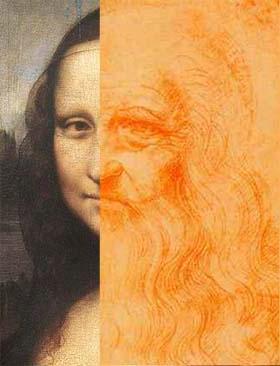
Secret Numbers Found in The Mona Lisa.
Other revelations of the Mona Lisa include:
- Lace on Mona Lisa’s dress
- The transparency of the veil shows da Vinci first painted a landscape and then used transparency techniques to paint the veil atop it.
- A change in the position of the left index and middle finger.
- The elbow was repaired from damage due to a rock thrown at the painting in 1956.
- The blanket covering Mona Lisa’s knees also covers her stomach.
- The left finger was not completely finished.
- A blotch mark on the corner of the eye and chin are varnish accidents, countering claims that Mona Lisa was sick.
- And the Mona Lisa was painted on uncut poplar board, contrary to speculations.
Experts say the barely distinguishable letters and numbers represent something of a real-life Da Vinci code.
The revelation could have come straight from the pages of Dan Brown’s best-seller The Da Vinci Code, in which the Mona Lisa is said to contain hidden clues about the Holy Grail.
Silvano Vinceti, president of Italy’s National Committee for Cultural Heritage, which spotted the symbols, said: ‘To the naked eye the symbols are not visible but with a magnifying glass they can clearly be seen.
‘In the right eye appear to be the letters LV which could well stand for his name, Leonardo da Vinci, while in the left eye there are also symbols but they are not as defined.
‘It is very difficult to make them out clearly but they appear to be the letters CE, or it could be the letter B.
‘In the arch of the bridge in the background the number 72 can be seen or it could be an L and the number 2.
‘You have to remember the picture is almost 500 years old so it is not as sharp and clear as when first painted.
‘From the preliminary investigations we have carried out we are confident they are not a mistake and were put there by the artist.’
The search was initiated by another Dan Brown-style plot device after a fellow committee member discovered a musty book in an antique shop referring to symbols in the Mona Lisa’s eyes.
Mr Vinceti added: ‘Da Vinci put a special emphasis on the Mona Lisa and we know that in the last years of his life he took the painting with him everywhere.
‘We also know that da Vinci was very esoteric and used symbols in his work to give out messages.
‘Who knows, they may even possibly be a love message to the figure in the painting.’
Mr Vinceti is a member of a group which is seeking permission to exhume da Vinci’s remains from his tomb at Amboise Castle in France’s Loire Valley.
They want to see if the artist’s skull is there so that they can try and recreate his face and establish if the Mona Lisa – owned by the French government and on display in The Louvre – is in fact a twist on a self-portrait of the artist as some believe.